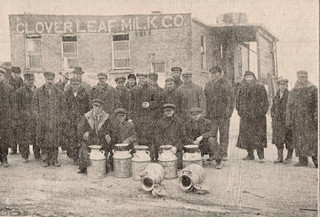
(Click on image to enlarge)
Unidentified Lake County milk shippers on strike in the spring of 1916. From S.J. Craig, The Lake County Agricultural Advisor (Crown Point: Lake County Star, 1916).
After the tuberculin-testing crisis of 1908-09, the northwest-Indiana dairy industry settled down for a time. In November 1914 the discovery of hoof-and-mouth disease among some newly arrived livestock in Merrillville and Wheeler resulted in a quarantine; but by the early spring of 1915, Lake County Agent S.J. Craig was assuring locals that the quarantine was practically lifted, and the hoof-and-mouth scare was over.
And so dairy farming went on with just the usual difficulties, which always included the struggle for a share of the industry's profits. The railroads that carried the milk into Chicago sought to profit from the transportation as much as the market would bear. So did the Chicago dealers and retailers who sold the milk to the consumer. For several years leading up to the spring of 1916, those retailers had managed to increase their own cut, until the dairy farmers lost patience with what seemed to them an unfair division of profits.
The local farmers were well organized. Lake County had its own milk producers' association of many years' standing, with John Gruel now its president. Porter County had a similar organization. These two Indiana counties joined with eight counties in Illinois and three in Wisconsin to form a regional Milk Shippers' Association, representing a total of 12,000 dairy farmers.
In March 1916, the regional association took the drastic step of declaring a five-day milk "famine" — a dairy-farmers' strike against Chicago — to begin on April 1. No milk would be shipped from any of the 13 organized counties surrounding the city. The Gazette's announcement of the strike conveyed a stern warning from the Milk Shippers' Association to "traitors" who might try to ship in defiance of the strike: any milk found on trains would be pulled off and dumped by the wayside.
On the first day of the strike, scarcely a dozen cans of milk went out from all of Hobart and Wheeler combined.
The Chicago retailers folded, fast. A few days into the strike, retailers began capitulating to the farmers' demands and signing new contracts — so many of them that, before a week had passed, milk shipments were almost back to normal.
The Gazette of April 14 printed an open letter from Roy Sherburne, one of the regional association's officers, declaring victory in the "milk war." He gave credit for the strike's success to "this great army of dairymen" whose "real co-operation and confidence in one another" gave the regional dairy association its power.
Sources:
♦ "Dairymen Win Milk Fight." Hobart Gazette 14 Apr. 1916.
♦ "Foot-and-Mouth Situation in Lake County." Hobart News 18 Mar. 1915.
♦ "Lake County Placed Under Quarantine." Hobart News 12 Nov. 1914.
♦ "Local Milk Shippers Elect Officers." Hobart Gazette 28 Jan. 1916.
♦ "Milk Fight Still On." Hobart Gazette 7 Apr. 1916.
♦ "Milk War On." Hobart Gazette 31 Mar. 1916.


No comments:
Post a Comment